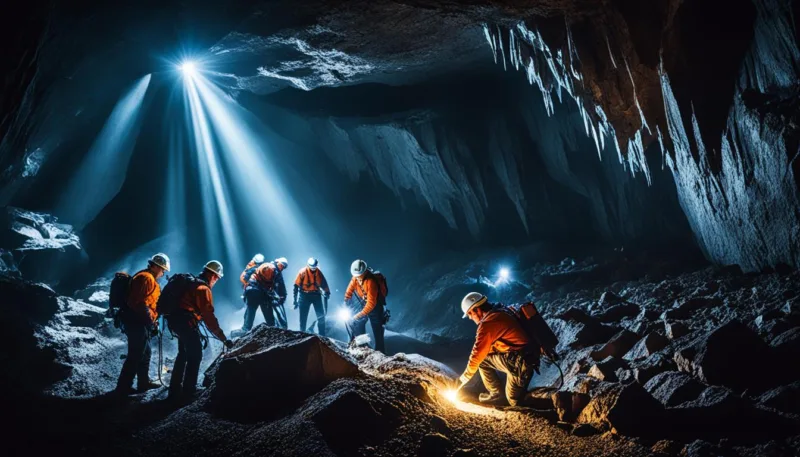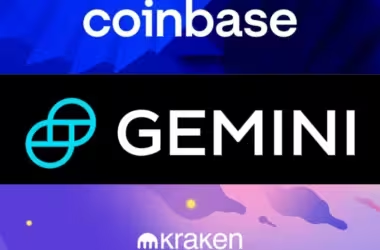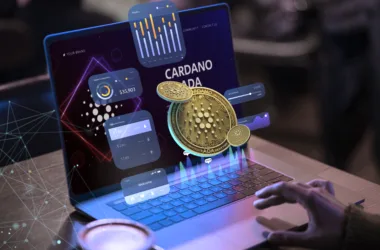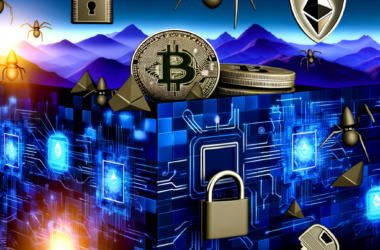Ever wondered how to mine bitcoin? It’s a vital process through which we verify transactions and find new blocks. This guide will teach you everything you need to start your bitcoin mining journey.
Key Takeaways
- Bitcoin mining involves solving complex mathematical problems to validate transactions and add new blocks to the blockchain.
- Miners are rewarded with newly minted bitcoins for their computational efforts.
- Specialized hardware, software, and a crypto wallet are essential requirements for bitcoin mining.
- Mining profitability depends on factors like hardware efficiency, electricity costs, and the cryptocurrency’s market value.
- Joining a mining pool can increase your chances of earning rewards by combining computing power with other miners.
Introduction to Bitcoin Mining
Bitcoin mining is about checking new transactions for the Bitcoin network. Miners use powerful computers for this. They add these transactions to a public list called the blockchain. This blockchain makes sure Bitcoin is safe and works for everyone.
What is Bitcoin Mining?
When it comes to Bitcoin mining, it’s like a race. Miners must solve hard math problems with their computers. The first one to solve the problem gets new Bitcoins and fees from the transactions.
The History of Bitcoin Mining
Bitcoin mining started in 2009 when Satoshi Nakamoto created the first Bitcoin. At first, people could mine Bitcoin using regular computers. But now, they need special, powerful machines.
Benefits of Bitcoin Mining
Mining Bitcoin can make you a lot of money. As Bitcoin becomes more valuable, so do the rewards for mining. Plus, mining makes the Bitcoin system safer and fairer for everyone using it.
Essential Requirements for Bitcoin Mining
Understanding the basics before you start mining Bitcoin is essential. You’ll need a bitcoin wallet to securely store your mined coins. Popular choices for wallets include Coinbase and Electrum, known for their security and ease of use.
The heart of mining Bitcoin is the mining hardware. This special equipment performs the hard job of mining. Most miners use ASIC devices for their high performance and efficiency.
Mining software is the link that brings your hardware and the Bitcoin network together. CGMiner, BFGMiner, and EasyMiner are popular programs. They help your hardware mine effectively by following the network’s instructions.
Bitcoin or Crypto Wallet
Keeping your mined Bitcoin safe starts with a bitcoin wallet. There are many types, like software, hardware, and online wallets. Each has its own benefits, including how secure and easy they are to use.
Mining Hardware
The type of mining hardware you pick affects how well and how much you mine. ASICs dominate today because they’re made just for mining. They outperform other devices and are more energy efficient.
Mining Software
Your mining hardware needs mining software to connect with the Bitcoin network. These programs help manage your mining operation efficiently. CGMiner, BFGMiner, and EasyMiner are examples of good software with different features.
Types of Mining Hardware
The world of cryptocurrency mining has introduced different kinds of hardware over time. These solutions meet the growing needs of the industry. Choosing the right mining hardware is key to achieving success in cpu mining, gpu mining, fpga mining, and asic mining.
In the beginning, people primarily used their Central Processing Units (CPUs) for mining. This method worked well for cryptocurrencies like Bitcoin. But as the puzzles became more complex, CPUs found it hard to keep up. They were not as efficient and needed more time.
GPU Mining
To get around this, miners started using Graphical Processing Units (GPUs). These GPUs are much better for handling several tasks at once. This method was called GPU mining.
Miners built rigs with multiple GPUs. They found that this increased their mining power a lot. This step was very important in the history of mining because it made mining more efficient and profitable.
FPGA Mining
Later on, miners began to use Field Programmable Gate Arrays (FPGAs). FPGAs can be changed to fit certain tasks after they are made. This makes them a good fit for mining cryptocurrencies.
Even though they were more expensive, FPGAs use less energy and perform better.
ASIC Mining
Today, we have the most advanced mining hardware called Application-Specific Integrated Circuits (ASICs). These machines are made just for mining. They do the job better than CPUs, GPUs, and even FPGAs. ASICs are faster and more energy efficient.
The mining world keeps changing, and miners have to keep up. They need to look at all the hardware available. Things like cost, how energy efficient the hardware is, and how much money it can make are important. This helps them choose what’s best for their mining needs.
How to Mine Bitcoin
To start mining Bitcoin, you must complete a few key steps. First, get a bitcoin wallet setup to keep your bitcoins safe. You can choose from different types of wallets. Some are hot and connect to the internet, while others are cold and offer more security because they’re offline.
Select Your Mining Hardware
Choosing the right mining hardware selection is crucial. ASICs are top-notch for Bitcoin mining. They provide much bigger computational power than ordinary CPUs or GPUs.
Choose a Mining Pool
Mining Bitcoin by yourself is possible but not the best idea. It’s better to join a mining pool. This way, you combine your power with others, making your chances of earning Bitcoin better.
Download Mining Software
You also need to download mining software for the job. Make sure it fits both your hardware and your system. This software talks to the mining pool and the Bitcoin network. It lets your computer join the mining effort.
Configure Your Mining Software
Setting up the software with your hardware involves a few steps. You’ll connect your gear to your chosen mining pool. This means registering some details, like the pool’s URL and your wallet address.
Start Mining
After all the setup, you’re ready to mine Bitcoin. Your hardware will start solving problems and checking transactions on the Bitcoin network.
Monitor Your Mining Activity
Keep an eye on your mining activity. Watch how well your pool, hardware, and personal performance are doing. This helps you spot and fix problems fast. It keeps your mining running smoothly and making money.
Profitability of Bitcoin Mining
Getting into bitcoin mining can pay off well. But it’s key to know what boosts or lowers your chances of making money. Yes, the rise in Bitcoin’s price has made it more profitable. However, there are many pieces to the puzzle that decide how much you earn through mining.
Factors Affecting Bitcoin Mining Profitability
The money you make from bitcoin mining depends on a few important things. These include:
- Mining hardware capabilities: Better technology solves problems quicker, but it’s usually pricier.
- Electricity costs: Getting electricity for less money is crucial since it’s a big part of mining costs.
- Maintenance costs: Changing and cooling equipment, plus pool fees, can change how much money you make.
- Bitcoin’s market value: If Bitcoin’s price changes a lot, it can directly change how much you earn.
Calculating Mining Profitability
To see if bitcoin mining can be profitable, you must look at many things and do some math. Start by figuring out how much you could make based on your technology’s efficiency, Bitcoin’s current price, and how tough it is to mine. Then, subtract the costs like electricity, equipment, and upkeep to find your real profit.
There are many calculators online for figuring out if you can make money by mining bitcoin. But remember, these tools use guesses and can change a lot with the market and other conditions.
Mining Pools: Pros and Cons
Interested in bitcoin mining? Joining a mining pool has its benefits. It lets miners pull their resources together. This increases the group’s chance of successfully mining a block. Thus, earnings in bitcoin become more steady compared to mining on your own.
Choosing the right mining pool is key. You should look at the pool’s fees, size, and what others in the mining world think. Yes, mining pools can make for a more consistent income. But, they also have downsides. These include smaller rewards because fees are shared. There’s also a risk the pool might get too big and less fair.
- Advantages of Mining Pools:
- More chances to earn bitcoin rewards
- Steadier payouts, even with a small setup
- Less up-and-down in what you earn compared to going solo
- Disadvantages of Mining Pools:
- Earnings can be lower because of fees and sharing
- Big pools might become too powerful, with drawbacks
- You need to trust that your pool is dependable
Even though mining pools help miners, choosing wisely is important. Think about your resources and what risks you’re willing to take. Also, check the pool’s rules and how others see it.
Solo Mining vs. Pool Mining
In the bitcoin mining world, there are two main paths: solo mining and pool mining. Both ways of mining come with their own benefits and difficulties. Knowing the differences is key before you start mining.
Solo mining is when a person tries to solve bitcoin puzzles alone. This is done without a mining pool. It looks good because all the block’s reward might be yours. But, it needs a lot of computer power and resources. So, it’s risky. The chance of finding a block alone is low, and the rewards might not come often.
Pool mining is much friendlier. Miners team up in a mining pool. By working together, they have more power to solve blocks. The rewards are shared depending on how much each person helped. Even if everyone’s share turns out smaller due to the pooling of fees, payments come regularly. This is good news for those with less strong computers.
- Solo miners keep all the block reward but take on more risk and might not get rewards as often.
- Pool miners get their rewards more regularly, even with a reduction for fees.
Deciding between solo mining and pool mining depends on many things. Your resources, how much you can handle risk, and if you want steady rewards. Thinking about the good and bad of each is the best way to choose what suits your mining goals and power.
Bitcoin Mining Difficulty and Adjustments
The bitcoin mining difficulty shows how hard it is to verify transactions and add new blocks on the Bitcoin blockchain. It’s key for keeping the network secure and controlling how many new bitcoins we get. When more people start mining, a system adjusts the difficulty level so blocks still come out every 10 minutes.
What’s really important is the target hash, set by the Bitcoin protocol. This target changes every 2,016 blocks to keep the block time at 10 minutes on average. If more miners join, making the whole system more powerful, it gets harder to find the right answer. But if mining power drops, it gets easier to keep things running well.
This adjustment happens about every two weeks, or every 2016 blocks. It’s crucial for a few reasons:
- It stops miners from making new bitcoins too fast, which could mess up the planned supply and lower the cryptocurrency’s value.
- It adjusts to the changing power miners bring, keeping everything fair and rewarding.
- It helps the mining network grow by letting new miners join in easily.
The bitcoin mining difficulty is always changing to keep everything in balance. This includes how fast blocks get made, how secure the network is, and the planned release of new bitcoins.
Energy Consumption and Environmental Impact
Bitcoin mining uses a lot of energy. It needs big computers to work. This, in turn, affects the environment. The energy it uses is as much as what whole countries use in a year. This has caused worry about things like greenhouse gas emissions and putting stress on the power supply.
To lessen its impact, some mines are going green. They use renewable energy or find ways to reduce waste. By doing this, they hope to lower the harm caused by their energy use.
Mining cryptocurrencies is growing in popularity. This means the issue of its energy and environmental impact is getting more attention. To make it sustainable, we need to find ways to use less energy and better sources. The goal is to keep the industry going for the future.
Legal and Regulatory Considerations
The legal aspects of mining cryptocurrencies are not simple. They change a lot from place to place. Some countries support cryptocurrency mining laws, but others ban it. Figuring out what bitcoin mining regulations are in your area is very important if you want to start.
Important areas to think about include:
- Taxation policies for mining profits
- Licensing requirements for mining operations
- Energy consumption rules and environmental policies
- Classification of cryptocurrencies as securities or commodities
Before you mine any cryptocurrency, make sure you know your local rules. You might need to set up your business, get permits, handle profits correctly, and use energy wisely.
Not following bitcoin mining regulations can lead to big fines, legal problems, or your operations being stopped. As the mining world grows up, the legal aspects of mining will also change. This means miners need to keep up with the new rules.
Crypto Mining Alternatives
Mining cryptocurrencies is a well-known way to get digital currencies. But, it’s not the only way. Many alternatives to mining exist. These let you earn or get digital currencies in different ways. New ways to earn crypto keep appearing, meeting people’s various needs and abilities.
Earning crypto through small tasks is one option. Platforms like Coinbundle and Coinworker pay users to do simple tasks. This way of earning crypto is easier and needs less effort than mining.
- Interest-bearing crypto accounts, similar to traditional savings accounts, offer another way to earn passive cryptocurrency income by staking or lending your existing holdings.
- Airdrops, where new cryptocurrencies are distributed for free to eligible participants, provide an opportunity to obtain tokens without any financial investment.
- Staking involves pledging your crypto assets to help validate transactions on a Proof-of-Stake blockchain, earning rewards in the process.
- Trading cryptocurrencies on exchanges allows investors to potentially profit from market fluctuations, although this carries inherent risks.
For those just starting in the crypto world, these alternatives to mining could be better. They often cost less and require fewer tech skills. Using several crypto earning methods at once can lower risks. It offers a more well-rounded crypto investment strategy.
Bitcoin Mining Security and Risks
Getting into bitcoin mining brings both rewards and risks. The chance to make money is big. But, it’s important to be careful and understand the risks well.
One major risk is a 51% attack. This happens when one miner or group controls over half the network. They could then change the rules or attack the system, which is why decentralization is key.
Also, joining mining pools has its own risk. While they can offer more consistent rewards, if they get too big, they might make the network less decentralized.
- If you lose your wallet or someone steals your keys, you could lose what you’ve mined forever.
- Problems with your hardware or upkeep can stop your mining and cost you a lot of money in downtime.
- Dealing with laws and regulations wrongly could get you in trouble, which can be bad for your mining operation.
To lessen these risks, miners must focus on security. This means having backup plans for your hardware and storing most of your funds offline. Also, knowing and obeying the laws in your area is very important. At all costs, stopping attacks and securing your coins is what matters most for a good mining operation.
- Always update your security and software to stop cyber-attacks.
- Use strong passwords and extra layers of protection for your accounts and wallets.
- Spread out your mining work between several pools and areas to make things safer.
Future of Bitcoin Mining
The future of Bitcoin mining is full of changes. The mining process keeps getting harder. It’s expected that advancements in mining technology and better energy solutions will come.
There might be a move to big, centralized mining. Or, there could be a change to using less energy, like with Proof-of-Stake. This would help lower Bitcoin mining’s energy needs.
Two big things will shape Bitcoin mining’s future: clear rules and more people using cryptocurrencies. Getting these right will be key. It will help make Bitcoin mining not just profitable, but also energy-efficient and rule-following.
- Continuous hardware innovations for improved efficiency
- Exploration of alternative consensus mechanisms
- Establishment of clear regulatory frameworks
- Increased adoption and mainstream acceptance
Conclusion
This guide offers vital insights for new miners eager to start with bitcoin. It explains mining’s role in verifying transactions and securing the Bitcoin network. Miners earn bitcoins for their work. Yet, mining isn’t without costs. It needs special hardware, software, energy, and more.
Starting your mining journey means considering the hash rate, electricity costs, rules, and market prices. It’s important to understand that mining has challenges like high energy use and risk of becoming centralized. But, it’s a key way new bitcoins are created, growing the technology and its community. This guide is valuable for anyone looking to get involved in mining.
Learning the basics, methods, and rewards of mining is key for beginners. Armed with this knowledge, they can decide whether mining is right for them. With the right approach and dedication, mining can be a profitable and exciting experience in the world of digital currency.






